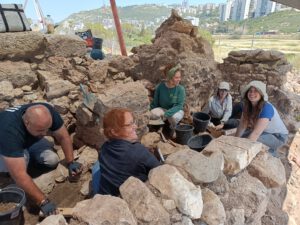
A new study undertaken at the University reveals the unique and complex history of the biblical settlement of Tel Shiqmona. It turns out that Tel Shiqmona provides one of the most fascinating and important examples of the thriving Kingdom of Israel and its extensive conquests to the northwest between the mid-ninth and mid-eighth centuries BCE. The study shows that one of the kings of the Omride dynasty (the House of Omri) took over a small Phoenician village that produced purple dye and turned it into a fortified factory for extensive production of the precious dye on an industrial scale. The factory, which since then was under the control of the Kingdom of Israel, is the only one found to date from this period in the entire Mediterranean. The factory supplied the prestigious and rare dye to kingdoms across the region, and its products were probably also used in the weaving of the parochet or sacred curtain in the Temple. “Under Israelite control, the factory at Tel Shiqmona supplied purple products, in all likelihood mainly purple-dyed fibers, to Cyprus and Lebanon, as well as to the sociopolitical elites and temples in the cities of the Philistines, Judah, and of course to high society in the Kingdom of Israel. Since production at Shiqmona was most extensive and the site was the closest production site to Jerusalem (and indeed, as noted, the only factory known s from this period), it is very likely that it also provided the prestigious purple dye for the Temple,” add archaeologists Prof. Ayelet Gilboa and Dr. Golan Shalev of the University.
Tel Shiqmona, a small hill on the western coast of modern-day Haifa, occupies a small promontory between Mt. Carmel and the sea and has always been a source of mystery to archeologists. Occupation on the tell started in the Bronze Age (the Canaanite period, fifteenth to thirteenth centuries BCE) and then resumed in the Iron Age (the eleventh to sixth centuries BCE) – a period that coincides with the period of the biblical Judges, the United Kingdom, the Kingdoms of Israel and Judah, and on to the devastations, first of the Kingdom of Israel and later of the Kingdom of Judah. Throughout these periods, Tel Shiqmona was a very small site of no more than five dunams, in contrast to the surrounding lower Byzantine town, which extends over 100 dunams. The site has no agricultural hinterland, and the coast near it is rocky and unsafe for mooring and sailing, so it was also unsuitable for maritime commerce.
Five years ago, Prof. Gilboa and Dr. Shalev published a study that marked a breakthrough in the understanding of the ancient settlement. Based on a preliminary examination of finds from excavations conducted by Dr. Yosef Elgavish in the 1960s and 1970s, including numerous ceramic vats stained with purple dye, as well as large quantities of Phoenician pottery, they argued that the site served as a Phoenician factory for the production of purple dye, a rare and prestigious product in the period. Indeed, some of the finds, and part of the architecture clustered with the material culture of the Kingdom of Israel in the relevant period, particularly the casemate wall and the so-called “three-room houses”, but the assumption was that the production of purple dye was a Phoenician secret, and that most of the findings were consistent with Phoenician culture. Accordingly, the researchers concluded at the time that the site should be considered part of the Phoenician sphere.
However, after several years of intensive research into Dr. Elgavish’s findings, and after recently completing a new excavation of their own in a small section of the tell, Prof. Gilboa and Dr. Shalvi now present the complete historical reconstruction of the site in the relevant periods. They suggest that around the mid-9th century BCE the Kingdom of Israel seized control of the Phoenician production site. Under Israelite rule, Shiqmona became one of the most important production sites in the Mediterranean basin (the only one currently known). Thus the story of the tell adds a strong purple tint to the prosperous days of the Kingdom of Israel between the mid-ninth and mid-eighth centuries BCE – the days of the dynasties of Omri and Jehu.
According to Dr. Shalvi, the findings as a whole illustrate a more complex historical picture than previously reconstructed. In the early Iron Age, in the eleventh century BCE, local Phoenicians established a small site for the production of purple dye. In this period, the material culture at Shiqmona is defined as exclusively Phoenician and the site produces local purple dye on a limited scale.
At some point around the middle of the ninth century BCE, around the time that Ahab ascended the throne in the Kingdom of Israel, the factory was abandoned, and possibly destroyed. A new site was built on its ruins, including a casemate fortification wall in a style that is characteristic of many fortified settlements in the Kingdom of Israel in this period. The ceramics, including a large number of vessels of daily use, as well other finds such as seals, now begin to show Israelite characteristics alongside the Phoenician ones. They also suggest that the production of purple dye intensified considerably during this period. The new insights offer an understanding of the unique and fascinating historical story of this site: from a small Phoenician village producing purple dye to a fortified and well-planned factory, under Israelite control, but where Phoenicians continued to serve as expert craftsmen responsible for the acquisition of the marine shells and the production the dye.
The new proposal presented by Prof. Gilboa and Dr. Shalvi is consistent with the geopolitical developments in the region in the relevant period. The Kingdom of Israel flourished at the time, as Omri and later his son Ahab expanded the kingdom to the north and east, in part through military conquests. “The findings at Tel Shiqmona show that the enormous economic potential inherent in the ability to produce blue and purple dyes was one factor – and perhaps the most important one – that motivated the Kingdom of Israel to extend its campaigns of conquest toward the sea in the west. This enabled them to seize control of the legendary source of the Phoenicians’ wealth – the “Tyrian” purple industries. The harvesting of sea snails and the extraction of purple dye required a profound familiarity with the sea. Accordingly, it seems likely that Phoenician workers continued to be responsible for these activities, under the regulation of the Kingdom of Israel. These conclusions may explain the unusual combination of Israelite and Phoenician material cultural traits in the same archeological strata,” the researchers explain.
The finds at the site continue to tell the story of the Kingdom of Israel through to its ultimate demise. As the dynasty of Jehu came to power, eliminating the House of Omri, the factory appears to have been demolished, but then rebuilt, reaching its peak in size and scope of production during the long reign of Jeroboam II (son of Jehoash) in the first half of the eighth century BCE. This was the last period of prosperity in the Kingdom of Israel, which once again expanded its borders, probably including the Akko Plain just to the north of Shiqmona. The Israelite industrial casemate compound appears to have been destroyed shortly after the death of Jeroboam II, around 740 BCE. This period marked the beginning of the decline of the Kingdom of Israel as the result of internal conflicts, including frequent coups and regicides. The large-scale production of purple dye at Shiqmona only resumed in the first half of the seventh century BCE under Assyrian rule, following their devastation of the Kingdom of Israel. Around 600 BCE, the activity at the site ended during the Babylonian conquest of Western Asia.
“The story of the biblical site of Shiqmona proves to be far more complex and fascinating than we originally assumed. This is the most important factory for the production of purple dye from this period that has been found to date; the scope of production was several times larger than that of any other known site. Moreover, the site tells the story of the rise and fall of the Kingdom of Israel in the ninth and eighth centuries BCE from an unusual angle – that of the kingdom’s economic interests, its expansion to the west, and its complex relations with the Phoenicians. This period was dominated by the military and political might of the Kingdom of Israel, and the kingdom’s conquest and control of Shiqmona, with its production of purple dye, forms part of the economic foundation for this power,” the researchers conclude.
The study of Tel Shiqmona is being undertaken under the auspices of the Zinman Institute of Archeology at the University , supported by a cooperative endeavor of the Office of the President of the University of Haifa and the Municipality of Haifa, the Shelby White and Leon Levy Program for Archeological Publications at Harvard University, the Israel Science Foundation, the Hecht Foundation in Haifa, and the National Maritime Museum. The excavation team includes researchers, students, and volunteers: Sonia Pinsky, Eddi Avrahami, Sandy Katz, Moshe Diengott, Marva Agnon, Julie Mendelsohn, Dr. Naama Sukenik, Dr. Paula Waiman-Barak, Dr. Ehud Galili, Prof. Dorit Sivan, and Harel Shochat.
Following this renewed study, a new excavation was undertaken at Tel Shiqmona. This has now been completed and several bodies are now working jointly to conserve and develop the site in order to make it accessible to the public: The Nature and Parks Authority, the Zinman Institute of Archeology at the University of Haifa, the Haifa Municipality, the Israel Oceanographic and Limnological Research Institute, and the Israel Antiquities Authority27.2.23
photo: golan shalvi



